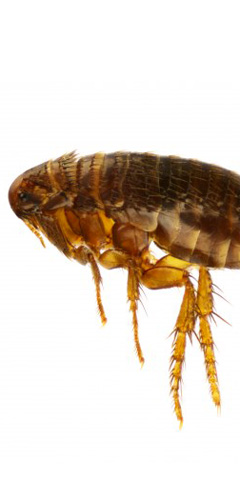- PEST PROBLEMS? CALL US NOW!
- 01865 362053 / 07802 485384
Pest Control for Fleas
(Ctenocephalides felis)
 It's a wise move to choose professional pest controller for flea removal - this way you can be sure fleas will be removed safely with minimal chance of return. Hawthorn Pest Control have extensive experience in eradicating both dog and cat fleas.
It's a wise move to choose professional pest controller for flea removal - this way you can be sure fleas will be removed safely with minimal chance of return. Hawthorn Pest Control have extensive experience in eradicating both dog and cat fleas.
Our experienced pest control team have specialist equipment to kill fleas and are able to discuss effective methods of flea control for both domestic and commercial environments. Using a professional pest controller for the job is the most reliable method of flea removal and is performed in such a way so as to ensure the chance of their return is kept to the bear minimum.
There are several different types of flea found in the UK. The most common form of flea
includes the cat flea (Ctenocephalides felis) and the dog flea (Ctenocephalides canis).
The flea is reddish brown in colour, about 2 – 3.25 mm long and 1mm high, and is flattened
laterally. The most distinctive features of dog and cat fleas are the large jumping legs and
row of black non-sensory spines on the front margin of the head and on the rear of the first
thoracic segment.
The adult flea feeds on blood from birds or mammals while the larvae feed on small particles
of organic matter. After mating, the female flea lays several hundred eggs in batches after each blood meal.
Common places for fleas to lay eggs include: dog and cat hair, bedding, resting sites and in
areas where dogs and cats can be found. The eggs are small, whitish and oval in shape, 0.5
mm, just visible with the naked eye. Although dogs and cats are the preferred host for fleas,
they are capable of feeding on humans, and frequently do. The distress caused by flea bites
can be considerable.
Flea eggs easily fall off the host animal to continue their life cycle in cracks and crevices on
the floor or in the lair or nest of the host. In warm conditions, the egg hatches in about 7 to
10 days into the larvae. The larvae is fully grown (5mm in length) after about 40 days. It then
pupates in a cocoon spun from a salivary secretion. The cocoons are normally covered with
dust and therefore difficult to discern. The adult eventually emerges after a further 14-21
days.
Fleas are extremely well adapted for their way of life. Their shell makes it almost impossible
to squash them and the tall, thin body allows them to move around very rapidly among hairs
or feathers. The creature is capable of jumping a vertical height of 30cm so it is easy for
them to move from one location to another and easily spread throughout an area.
It is worth noting that fleas have the ability to lie dormant in their cocoons for months or even
years until the vibrations of a likely host stimulate their emergence.
A cat or a dog may have a light infestation of fleas without the human inhabitants of the
house noticing, but if domestic animals are carrying large numbers of fleas, there is naturally
a greater likelihood that humans will be attacked. A big problem may occur if the cat or dog
is removed from the house and the fleas left behind then have no choice but to move to
humans.
To eradicate fleas, all floors, floor coverings and skirting should be treated with a suitable
insecticide. Particular attention should be paid to cracks and crevices. Hawthorn Pest
Control is experienced in the eradicating of both dog and cat fleas and provide advice on
preventing a re-infestation.

